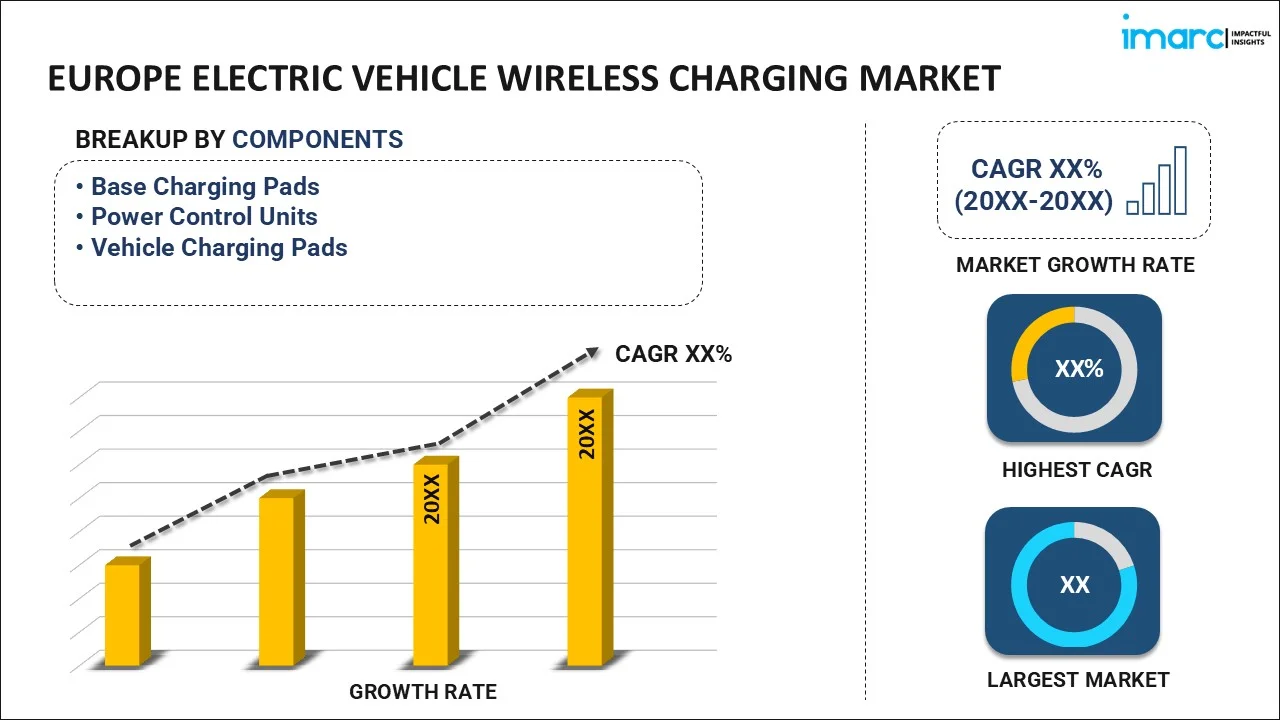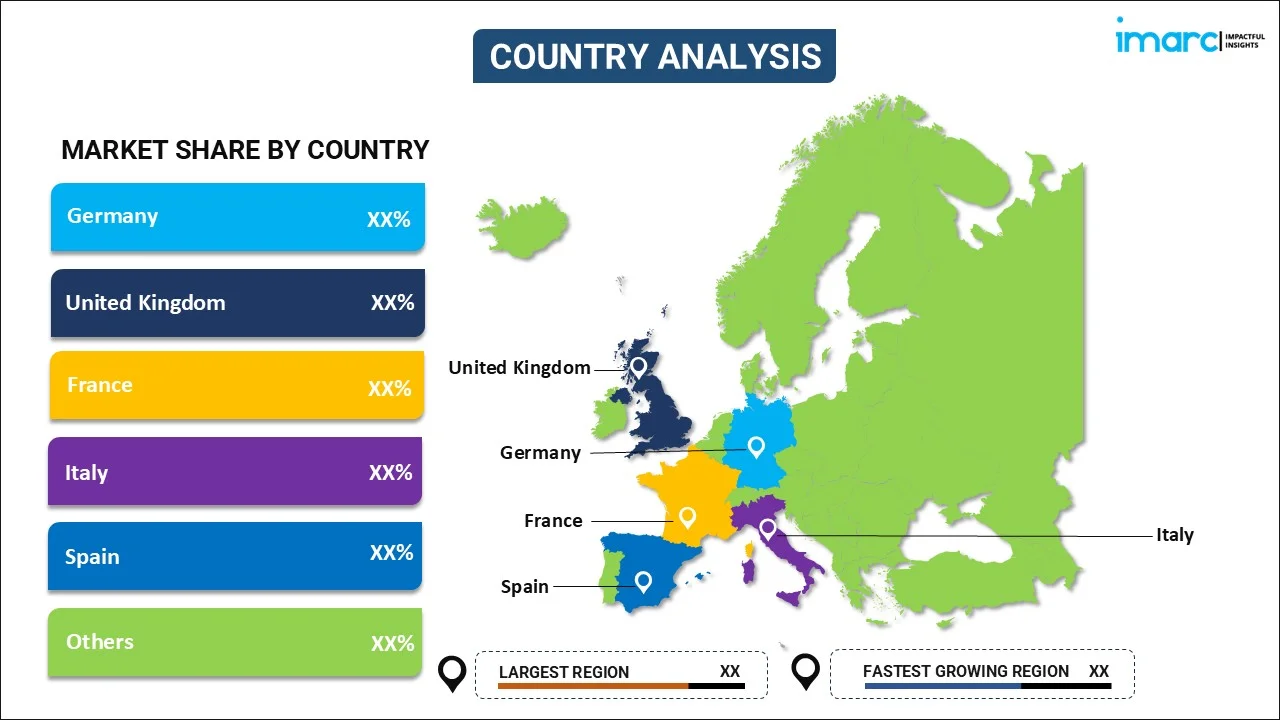
Europe Electric Vehicle Wireless Charging Market Size, Share, Trends and Forecast by Component, Charging Type, Propulsion, Vehicle Type, Power Supply Range, Charging System, Application, and Country, 2025-2033
Europe Electric Vehicle Wireless Charging Market Overview:
The Europe electric vehicle wireless charging market size reached USD 32.72 Million in 2024. Looking forward, IMARC Group expects the market to reach USD 601.76 Million by 2033, exhibiting a growth rate (CAGR) of 38.20% during 2025-2033. The increasing government incentives for EV adoption, advancements in inductive charging technology, rising demand for convenience-driven charging solutions, growing investments in smart infrastructure, and supporting sustainable urban mobility solutions are some of the major factors positively impacting the Europe electric vehicle wireless charging market share.
|
Report Attribute
|
Key Statistics
|
|---|---|
|
Base Year
|
2024 |
|
Forecast Years
|
2025-2033
|
|
Historical Years
|
2019-2024
|
| Market Size in 2024 | USD 32.72 Million |
| Market Forecast in 2033 | USD 601.76 Million |
| Market Growth Rate (2025-2033) | 38.20% |
Europe Electric Vehicle Wireless Charging Market Trends:
Increasing EV Adoption Driving Demand for Wireless Charging
The rapid growth of electric vehicle adoption across Europe is a primary factor accelerating the demand for wireless charging solutions, which is positively influencing the Europe electric vehicle wireless charging market outlook. According to the Global EV Outlook 2024 report by the International Energy Agency, the number of new electric car registrations in Europe increased by about 20% from 2022 to 2023, reaching approximately 3.2 million. Sales reached 2.4 million in the EU, with increasing growth rates. Governments in nations such as Germany, France, and the Netherlands are enforcing strict emissions standards and providing financial incentives for buying EVs, resulting in a boom in new registrations. Moreover, the region's goals of carbon neutrality by 2050 further drive the shift towards EVs and enhance the demand for affordable and efficient charging options. Consumers and fleet operators are increasingly valuing convenience-driven charging solutions, with wireless charging resolving major issues like plug wear, cable mess, and ease of use for those with limited mobility. Automakers are reacting by incorporating wireless charging functionality into future EV models, making the technology a mainstream competitor to conventional charging stations. With increasing EV penetration, the installation of wireless charging infrastructure will increase substantially with support from public as well as private sector investments.
Strategic Partnerships Between Automakers and Technology Providers
Strategic collaborations between automakers, charging technology companies, and infrastructure providers are accelerating the Europe electric vehicle wireless charging market growth. Companies are forming alliances with technology companies specializing in inductive charging to facilitate faster development and deployment of standardized charging systems. These partnerships are necessary for the testing of new technology across different vehicle models for interoperability and efficiency. Furthermore, joint ventures between automakers and energy companies facilitate the deployment of wireless charging networks in urban and highway settings. Such strategic alliances are leading to streamlining the development process, lowering expenditures, and moving toward mass adoption of wireless charging in both residences and businesses. For instance, in August 2024, Oak Ridge National Laboratory (ORNL) researchers achieved a milestone by demonstrating a 270-kilowatt wireless power transmission system, creating a new benchmark for electric vehicle (EV) charging. This system, developed in collaboration with the Volkswagen Group, a German automobile manufacturer, successfully wirelessly charged a Porsche Taycan, overcoming challenges associated with integrating high-power wireless charging into light-duty vehicles constrained by space and weight. The system, utilizing lightweight electromagnetic coils approximately 19 inches in diameter, maintains over 95% efficiency and can deliver a 50% charge in just 10 minutes.
Europe Electric Vehicle Wireless Charging Market Segmentation:
IMARC Group provides an analysis of the key trends in each segment of the market, along with forecasts at the regional level for 2025-2033. Our report has categorized the market based on component, charging type, propulsion, vehicle type, power supply range, charging system, and application.
Component Insights:

- Base Charging Pads
- Power Control Units
- Vehicle Charging Pads
The report has provided a detailed breakup and analysis of the market based on the component. This includes base charging pads, power control units, and vehicle charging pads.
Charging Type Insights:
- Dynamic Wireless Charging Systems
- Stationary Wireless Charging Systems
A detailed breakup and analysis of the market based on the charging type have also been provided in the report. This includes dynamic wireless charging systems and stationery wireless charging systems.
Propulsion Insights:
- BEVs
- PHEVs
The report has provided a detailed breakup and analysis of the market based on the propulsion. This includes BEVs and PHEVs.
Vehicle Type Insights:
- Commercial Vehicles
- Passenger Cars
A detailed breakup and analysis of the market based on the vehicle type have also been provided in the report. This includes commercial vehicles and passenger cars.
Power Supply Range Insights:
- Up to 3.7 kW
- Above 3.7–7.7 kW
- Above 7.7–11 kW
- Above 11 kW
The report has provided a detailed breakup and analysis of the market based on the power supply range. This includes up to 3.7 kW, above 3.7-7.7 kW, above 7.7-11kW, and above 11kW.
Charging System Insights:
- Magnetic Resonance Charging
- Inductive Charging
- Capacitive Charging
A detailed breakup and analysis of the market based on the charging system have also been provided in the report. This includes magnetic resonance charging, inductive charging, and capacitive charging.
Application Insights:
- Commercial Charging Stations
- Home Charging Units
The report has provided a detailed breakup and analysis of the market based on the application. This includes commercial charging stations and home charging units.
Country Insights:

- Germany
- France
- United Kingdom
- Italy
- Spain
- Others
The report has also provided a comprehensive analysis of all the major regional markets, which include Germany, France, United Kingdom, Italy, Spain, and others.
Competitive Landscape:
The market research report has also provided a comprehensive analysis of the competitive landscape. Competitive analysis such as market structure, key player positioning, top winning strategies, competitive dashboard, and company evaluation quadrant has been covered in the report. Also, detailed profiles of all major companies have been provided.
Europe Electric Vehicle Wireless Charging Market News:
- November 26, 2024: InductEV, based in Philadelphia, and ENRX, based in Norway, Europe. Signed a memorandum of understanding to establish technical standards and ensure compatibility across the wireless electric vehicle charging ecosystem. This collaboration aims to develop high-power wireless charging solutions in order to encourage the broad use of electric vehicles. By aligning their technologies, the partnership seeks to create an open ecosystem that fosters innovation and offers users expanded market access.
- March 23, 2023: WiTricity and BT e-Line announced a collaboration to launch aftermarket wireless EV charging systems in Europe. The Volkswagen ID.4 model will be upgraded during the first deployment, with availability anticipated in early 2024. There are plans to expand this technology to other EV models, such as the Volkswagen ID Buzz, Audi e-Tron GT, and Porsche Taycan.
Europe Electric Vehicle Wireless Charging Market Report Coverage:
| Report Features | Details |
|---|---|
| Base Year of the Analysis | 2024 |
| Historical Period | 2019-2024 |
| Forecast Period | 2025-2033 |
| Units | Million USD |
| Scope of the Report | Exploration of Historical Trends and Market Outlook, Industry Catalysts and Challenges, Segment-Wise Historical and Future Market Assessment:
|
| Components Covered | Base Charging Pads, Power Control Units, Vehicle Charging Pads |
| Charging Types Covered | Dynamic Wireless Charging Systems, Stationery Wireless Charging Systems |
| Propulsions Covered | BEVs, PHEVs |
| Vehicle Types Covered | Commercial Vehicles, Passenger Cars. |
| Power Supply Ranges Covered | Up to 3.7 kW, Above 3.7-7.7 kW, Above 7.7-11kW, Above 11kW |
| Charging Systems Covered | Magnetic Resonance Charging, Inductive Charging, Capacitive Charging |
| Applications Covered | Commercial Charging Stations, Home Charging Units |
| Countries Covered | Germany, France, United Kingdom, Italy, Spain, Others |
| Customization Scope | 10% Free Customization |
| Post-Sale Analyst Support | 10-12 Weeks |
| Delivery Format | PDF and Excel through Email (We can also provide the editable version of the report in PPT/Word format on special request) |
Key Questions Answered in This Report:
- How has the Europe electric vehicle wireless charging market performed so far and how will it perform in the coming years?
- What is the breakup of the Europe electric vehicle wireless charging market on the basis of component?
- What is the breakup of the Europe electric vehicle wireless charging market on the basis of charging type?
- What is the breakup of the Europe electric vehicle wireless charging market on the basis of propulsion?
- What is the breakup of the Europe electric vehicle wireless charging market on the basis of vehicle type?
- What is the breakup of the Europe electric vehicle wireless charging market on the basis of power supply range?
- What is the breakup of the Europe electric vehicle wireless charging market on the basis of charging system?
- What is the breakup of the Europe electric vehicle wireless charging market on the basis of application?
- What is the breakup of the Europe electric vehicle wireless charging market on the basis of country?
- What are the various stages in the value chain of the Europe electric vehicle wireless charging market?
- What are the key driving factors and challenges in the Europe electric vehicle wireless charging market?
- What is the structure of the Europe electric vehicle wireless charging market and who are the key players?
- What is the degree of competition in the Europe electric vehicle wireless charging market?
Key Benefits for Stakeholders:
- IMARC’s industry report offers a comprehensive quantitative analysis of various market segments, historical and current market trends, market forecasts, and dynamics of the Europe electric vehicle wireless charging market from 2019-2033.
- The research report provides the latest information on the market drivers, challenges, and opportunities in the Europe electric vehicle wireless charging market.
- Porter's five forces analysis assist stakeholders in assessing the impact of new entrants, competitive rivalry, supplier power, buyer power, and the threat of substitution. It helps stakeholders to analyze the level of competition within the Europe electric vehicle wireless charging industry and its attractiveness.
- Competitive landscape allows stakeholders to understand their competitive environment and provides an insight into the current positions of key players in the market.
Need more help?
- Speak to our experienced analysts for insights on the current market scenarios.
- Include additional segments and countries to customize the report as per your requirement.
- Gain an unparalleled competitive advantage in your domain by understanding how to utilize the report and positively impacting your operations and revenue.
- For further assistance, please connect with our analysts.

 Inquire Before Buying
Inquire Before Buying
 Speak to an Analyst
Speak to an Analyst
 Request Brochure
Request Brochure
 Request Customization
Request Customization



.webp)




.webp)












